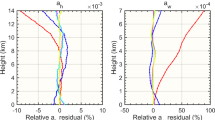Abstract
In GNSS, 3D geometric position is calculated with high accuracy. This position is the ellipsoidal latitude, longitude and ellipsoidal height \(\left( {\lambda ,\phi ,h} \right) \) with respect to WGS84 coordinates system. These coordinates are integrated with local horizontal/projected coordinates (X, Y) by mathematical coordinate’s transformations and map projections. The geometric ellipsoidal height (h) obtained by means of GNSS has to be integrated with the physical/orthometric heights (H) obtained by means of precise leveling. The physical surface defining the difference between both height systems is the geoid represented by the geoid undulation (N) at a given position. Different methods are used to build geoid models. Global models using terrestrial and satellite data are available to calculate the geoid heights as function of the earth potential (W). The most recent high degree and order models are EGM2008, Eigen05c, Eigen06c4, etc. (GFZ-Potsdam, ‘List of available global models. http://icgem.gfz-potsdam.de/ICGEM/modelstab.html, 2017). Some regional geoid models are available like the European Gravimetric Geoid (EGG97). These models mostly do not fit the local datum due to datum definition problems. Here, a group of precise height reference benchmarks measured with GNSS is used to fit the global models with the local vertical datum to define the local height reference system of Palestine. The accuracy of the different global geopotential models is evaluated before and after the application of the geoid fitting.
Similar content being viewed by others
References
GFZ-Potsdam.: List of available global models. http://icgem.gfz-potsdam.de/ICGEM/modelstab.html (2017)
Gavish, D.: The Survey of Palestine Under the British Mandate, 1920–1948, vol. 1. Routlege, New York (2010)
Ghilani, C.; Wolf, P.: Elementary Surveying: An Introduction to Geomatics, 12th edn. Pearson Prentice Hall, Upper Saddle River (2008)
Younis, G.: Regional Gravity Field Modeling with Adjusted Spherical Cap Harmonics in an Integrated Approach, vol. 39. Schriftenreihe Fachrichtung Geodäsie det Technischen Universtät Darmstadt, Darmstadt (2013)
Torge, W.; Müller, J.: Geodesy, 4th edn. Walter de Gruyter, Berlin (2012)
Younis, G.; Jäger, R.; Matthias, B.: Transformation of global spherical harmonic models of gravity field to a local adjusted spherical cap harmonic model. Arab J Geosci 6(2), 375–381 (2013)
Holmes, S.A.; Featherstone, W.E.: A unified approach to the Clenshaw summation and recursive computation of very high degree and order normalized associated Legendre functions. J Geodesy 76(5), 279–299 (2002)
Hofmann-Wellenhof, B.; Moritz, H.: Physical Geodesy, 2nd edn. Springer, Vienna (2006)
GFZ-Potsdam.: Calculation service. http://icgem.gfz-potsdam.com/service.html (2017)
Uni-Hannover, G.I.: European Gravimetric Geoid EGG97. https://www.ife.uni-hannover.de/egg97.html (2017)
Jäger, R: State of the art and present developments of a general concept for GPS-based height determination. In: First Workshop on GPS and Mathematical Geodesy in Tanzania (Kilimanjaro Expedition 1999), Kilimanjaro (1999)
Janpaule, I.; Jäger, R.; Younis, G.; Kaminskis, J.; Zarins, A.: DFHRS-based computation of quasi-geoid of Lativia. Geodesy Cartogr 39(1), 11–17 (2013)
Lu, Z.; Qu, Y.; Qiao, S.: Geodesy—An Introduction to Geodetic Datum and Geodetic Systems. Springer, Berlin (2014)
Ghilani, C.; Wolf, P.: Adjustment Computations: Spatial Data Analysis, 4th edn. Jones Willey and Sons Inc., Hoboken (2006)
Younis, G.: Local earth gravity/potential modeling using ASCH. Arab J Geosci 8(10), 8681–8685 (2015)
Younis, G.: Practical method to solve large least squares problems using Cholesky decomposition. Geodesy Cartogr 41(3), 113–118 (2015)
Farahani, H.; Klees R.; Slobbe, C.: Data requirements for a 5-mm quasi-geoid in the Netherlands. Studia Geophusica et Geodaetica 1–28 (2017)
Jäger, R.; Kaminski, J.; Strauhmanis, J.: Determination of quasi-geoid as height component of the geodetic infrastructure for GNSS-positioning in the Baltic States. Lativian J. Phys. Tech. Sci. 49(3), 5–15 (2012)
Author information
Authors and Affiliations
Corresponding author
Rights and permissions
About this article
Cite this article
Younis, G. The Integration of GNSS/Leveling Data with Global Geopotential Models to Define the Height Reference System of Palestine. Arab J Sci Eng 43, 3639–3645 (2018). https://doi.org/10.1007/s13369-017-2912-5
Received:
Accepted:
Published:
Issue Date:
DOI: https://doi.org/10.1007/s13369-017-2912-5




